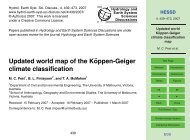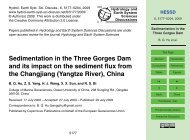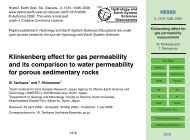In-situ evaluation of internal drainage in layered soils (Tukulu - hessd
In-situ evaluation of internal drainage in layered soils (Tukulu - hessd
In-situ evaluation of internal drainage in layered soils (Tukulu - hessd
You also want an ePaper? Increase the reach of your titles
YUMPU automatically turns print PDFs into web optimized ePapers that Google loves.
5<br />
10<br />
15<br />
20<br />
25<br />
5<br />
10<br />
15<br />
20<br />
25<br />
structure, respectively. A smooth transition between the A and B horizons confirmed<br />
the common attributes <strong>of</strong> these horizons <strong>in</strong>clud<strong>in</strong>g among others colour, texture and<br />
youthfulness <strong>of</strong> structure. <strong>In</strong> contrast, the clear abrupt transition between the B and C<br />
horizon expla<strong>in</strong>ed the sudden <strong>in</strong>crease <strong>in</strong> clay plus silt <strong>in</strong> the C horizon, which gave the<br />
horizon grey colours compared to the red colours <strong>of</strong> the upper horizons. The dist<strong>in</strong>ct<br />
layer<strong>in</strong>g on the lower strata was also confirmed the sudden drop <strong>in</strong> K s from 40 mm h −1<br />
<strong>in</strong> the B horizon to 9.6 mm h −1 <strong>in</strong> the C horizon. Yellow, grey and olive mottled colours<br />
<strong>in</strong> the C horizon shown <strong>in</strong> Fig. 1b could also be regarded as <strong>in</strong>dicators, not only <strong>of</strong> the<br />
<strong>in</strong>tensity <strong>of</strong> layer<strong>in</strong>g, but also <strong>of</strong> the wet soil water regime <strong>of</strong> this horizon.<br />
Sepane: The soil was classed as an orthic A, pedocutanic B and prismacutanic C<br />
horizon shown <strong>in</strong> Fig. 2. The clay plus silt fraction <strong>of</strong> the three horizons was 21 %,<br />
41 % and 47 %, respectively. Correspond<strong>in</strong>g bulk densities to the respective horizons<br />
were 1670, 1790 and 1730 kg m −3 . Accompany<strong>in</strong>g the <strong>in</strong>crease <strong>in</strong> clay plus silt content<br />
with depth, was the transformation <strong>in</strong> horizon textural classes from f<strong>in</strong>e sandy loam<br />
<strong>in</strong> the A horizon to a f<strong>in</strong>e sandy clay loam <strong>in</strong> the B horizon and to f<strong>in</strong>e sandy clay <strong>in</strong><br />
the C horizon. Structural properties unique to these horizon layers were the massive<br />
apedal, moderate to course sub angular blocky, and medium to strong prismatic structure,<br />
respectively. An abrupt transition between the A and B horizons and the smooth<br />
transition between the B and C horizons expla<strong>in</strong>ed the concentration <strong>of</strong> structure between<br />
lower horizons <strong>of</strong> this soil. Changes <strong>in</strong> red colours from the surface to dull red<br />
and darker colours <strong>of</strong> the <strong>in</strong>terior also po<strong>in</strong>ted to layer<strong>in</strong>g that occurred at 300 mm<br />
depth splitt<strong>in</strong>g this soil <strong>in</strong>to a weakly developed surface and well structured B and C<br />
horizons. Confirm<strong>in</strong>g the contrast <strong>in</strong> structure between the surface and B horizon were<br />
the well-developed and dist<strong>in</strong>ct peds with clay sk<strong>in</strong>s shown <strong>in</strong> Fig. 2b.<br />
Swartland: The soil was classed as an orthic A, pedocutanic B and saprolite C<br />
horizon, shown <strong>in</strong> Fig. 3. The clay plus silt fraction for the three horizons was 14 %,<br />
27 % and 21 %, respectively. Correspond<strong>in</strong>g bulk densities to the respective horizons<br />
were 1670, 1530 and 1450 kg m −3 , respectively. A smooth transition occurred between<br />
the surface and B horizons <strong>in</strong>dicat<strong>in</strong>g a gradual build-up <strong>in</strong> clay content, which resulted<br />
9807<br />
from the f<strong>in</strong>e sandy loam <strong>in</strong> the A horizon transformed <strong>in</strong>to a f<strong>in</strong>e sandy clay loam <strong>in</strong> the<br />
B horizon. Between lower horizons there was an abrupt transition from a sub-angular<br />
blocky structure <strong>in</strong> the B horizon to the saprolite rock <strong>of</strong> the C horizon. The presence <strong>of</strong><br />
dolorite <strong>in</strong>trusions and many black sesquioxides concretions shown <strong>in</strong> Fig. 3b at depths<br />
<strong>of</strong> 200–400 mm expla<strong>in</strong>ed the general course appearance and lack <strong>of</strong> abrupt transition<br />
<strong>in</strong> this soil. Although levels <strong>of</strong> calcium and magnesium showed to <strong>in</strong>crease with depth<br />
the predom<strong>in</strong>ance <strong>of</strong> a weakly weathered saprolite at shallow depths <strong>of</strong> 400 mm also<br />
reflected the deficiencies <strong>in</strong> structure and subsequent dry water regime <strong>of</strong> this soil.<br />
3.2 θ-h relationship <strong>of</strong> soil horizons<br />
Figure 4a–c shows the result<strong>in</strong>g θ-h relationships from the hang<strong>in</strong>g column laboratory<br />
desorption <strong>of</strong> the <strong>Tukulu</strong>, Sepane and Swartland soil, respectively. L<strong>in</strong>ear regression<br />
functions for each <strong>of</strong> the three <strong>soils</strong> horizons with the goodness <strong>of</strong> fit are shown <strong>in</strong><br />
Table 2. Correspond<strong>in</strong>g student’s t-test analysis for differences between the horizons<br />
regressions coefficients are also presented <strong>in</strong> Table 3. Designated to capture the soil<br />
water release behaviour under <strong><strong>in</strong>ternal</strong> <strong>dra<strong>in</strong>age</strong> conditions, the θ-h relationship was<br />
set between the suction ranges <strong>of</strong> 0 to 1000 mm (10-kPa). Spatial variations among<br />
the three <strong>soils</strong> appeared to <strong>in</strong>crease with suction, an essential <strong>in</strong>dicator for evaluat<strong>in</strong>g<br />
the permissibility <strong>of</strong> water release by the various soil horizons.<br />
<strong>Tukulu</strong>: The θ-h relationships from the A, B and C horizons appeared to cluster together<br />
at near zero suctions but after suctions <strong>of</strong> 200 mm their spatiality <strong>in</strong>creased. The<br />
A horizon released water from 0.33 to 0.277 mm mm −1 while the B horizon showed a release<br />
from 0.325 to 0.285 mm mm −1 when suction was <strong>in</strong>creased from 0 to 1000 mm.<br />
On the other hand, the C horizon released water from 0.324 to 0.321 mm mm −1 for the<br />
same suction range, result<strong>in</strong>g <strong>in</strong> a θ-h l<strong>in</strong>e that had an almost level slope. Effective<br />
saturation satisfied porosity only <strong>in</strong> the C horizon while the A and B horizons were below<br />
with 3 % and 1 %, respectively. Correspond<strong>in</strong>g slopes to these θ-h relationships<br />
was 0.005 %, 0.004 % and 0.0003 % for the respective A, B and C horizons with the B<br />
horizon hav<strong>in</strong>g the slowest water release function. Although the A and B horizon l<strong>in</strong>es<br />
9808<br />
Discussion Paper | Discussion Paper | Discussion Paper | Discussion Paper |<br />
Discussion Paper | Discussion Paper | Discussion Paper | Discussion Paper |







